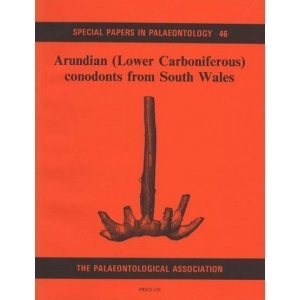
Special papers in Palaeontology: 46 Arundian (Lower Carboniferous) conodonts from South Wales.
1991
by J J Stone
63 pp.
ABSTRACT. A diverse conodont fauna has been recovered from a sample transect through the varied subenvironments of the carbonate ramp which existed to the south of St George's Land during Arundian times. The fauna includes the multi-element genera: Hindeodus, Hindeodus?, Cavusgna/hus, Pa/rogna/hus, Gna/hodus, Mes/ogna/hus, Polygnathus, Lochriea, Vogelgna/hus,ldioprioniodus and Kladogna/hus. Elements recovered but not referred to multi-element species are: Angulodus cf. sp. novo B of Rhodes e/ al. (1969), . Apa/ogna/hus' cuspida/us, . A.' libra/us, . A.' pelilus, Genicula/us cf. claviger and Gen. et sp. novo I. The outer ramp fauna is the most abundant and is dominated by species of Gna/hodus. The cavusgnathoid genera and Polygna/hus bischoffi were virtually confined to the more nearshore environments; and V ogelgna/hus cf. campbelli and 1Hindeodus sci/ulus, although recovered throughout the study area, were capable of living in littoral (euryhaline1) environments. Compared with previous records, the stratigraphical ranges of the following are extended: Cavusgna/hus ai/us, Gna/hodus cuneiformis and Idioprioniodus. Gna/hodus gir/yi is thought to have evolved from a previously undescribed gnathodontan - here termed G. aft'. girtyi. It is suggested that the form species Angulodus cf. sp. novo B and Gen. et sp. novo I belong to the same apparatus which may have been ancestral to Aethotaxis advena.